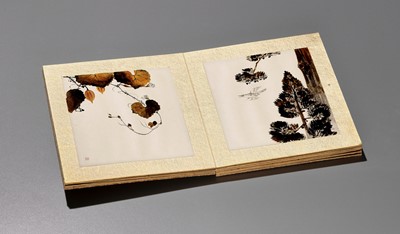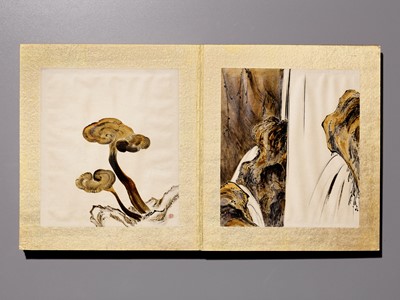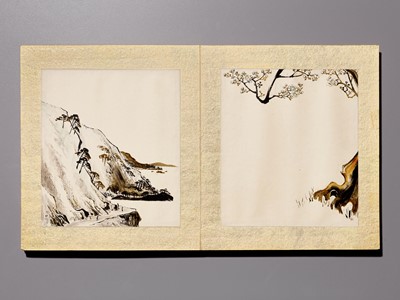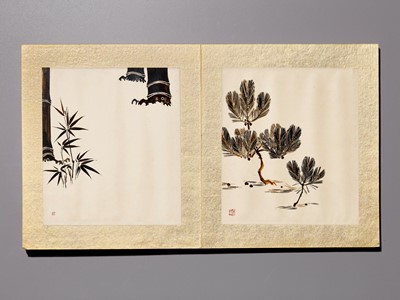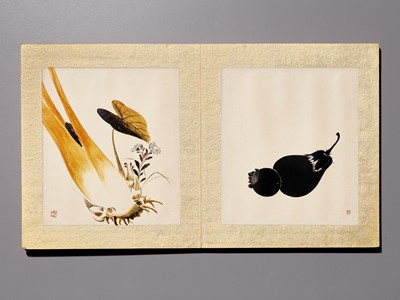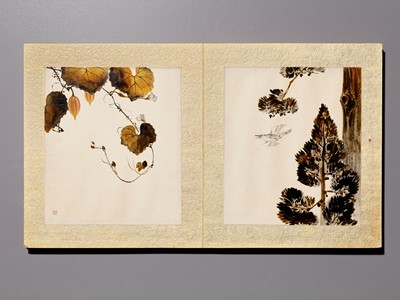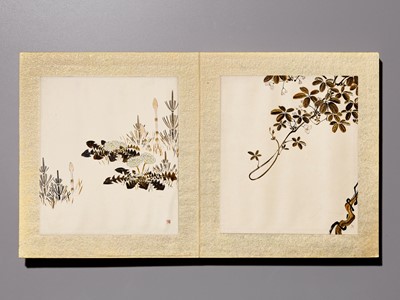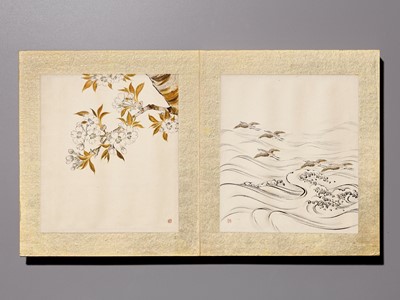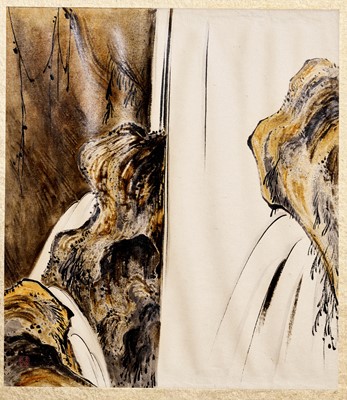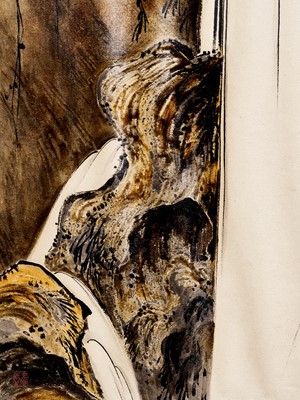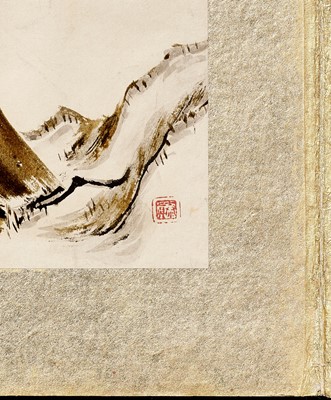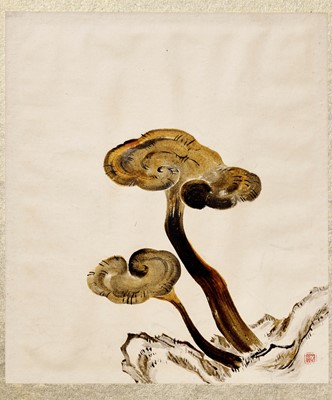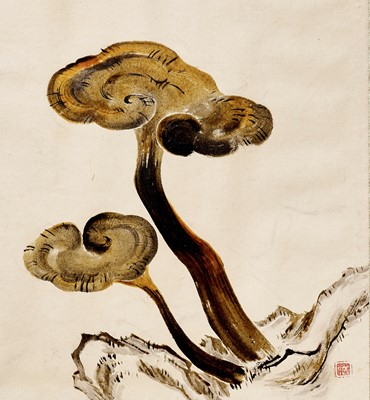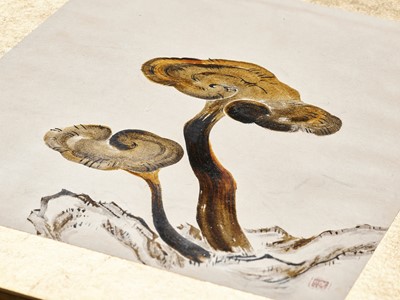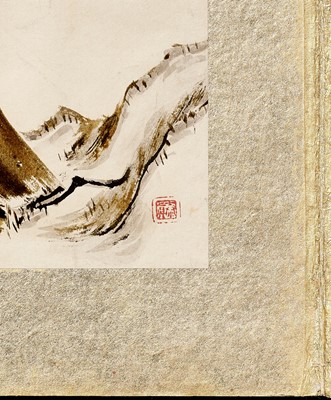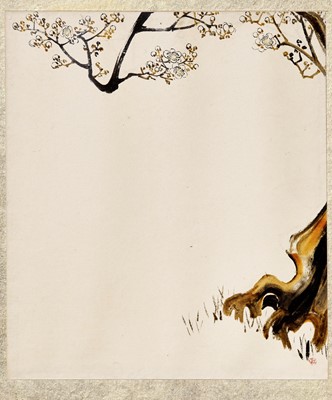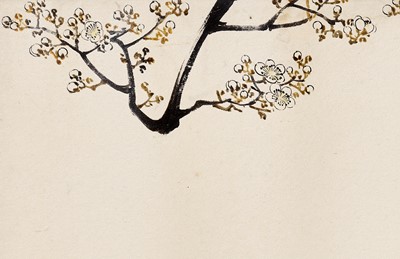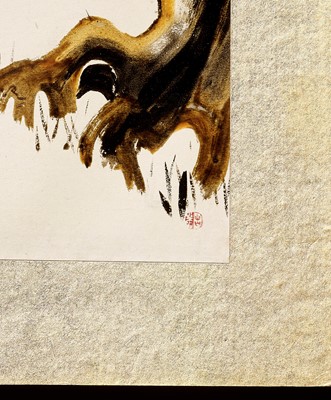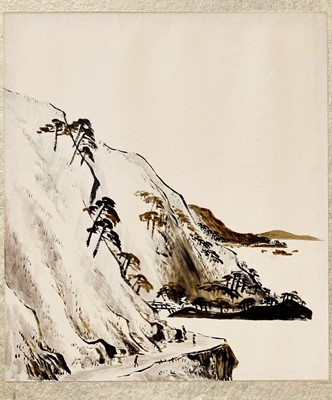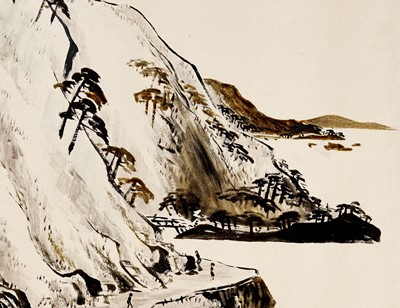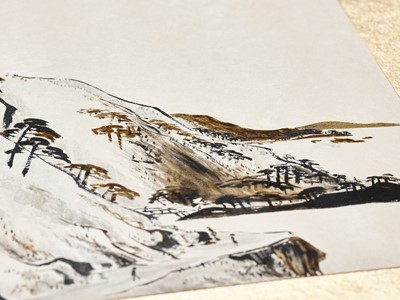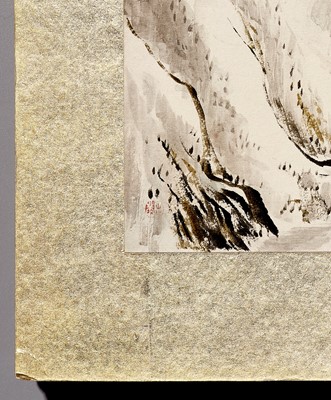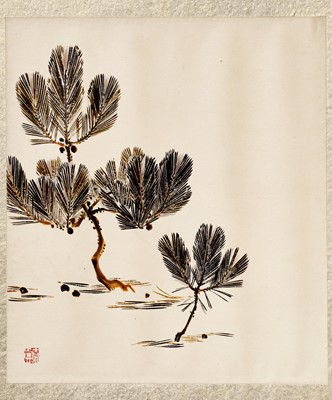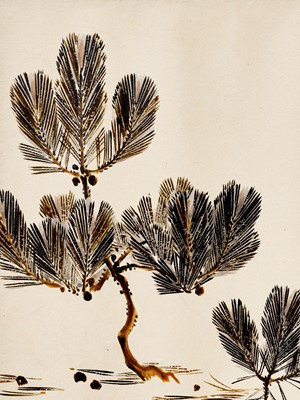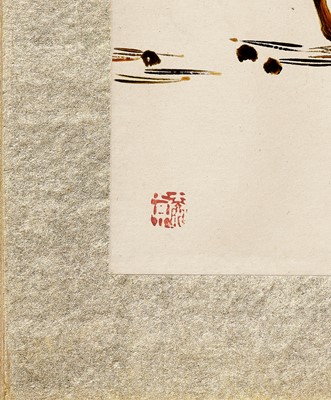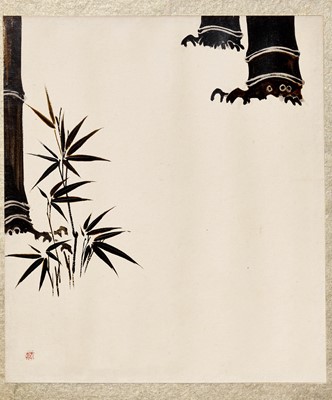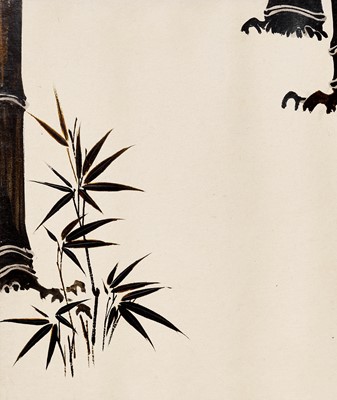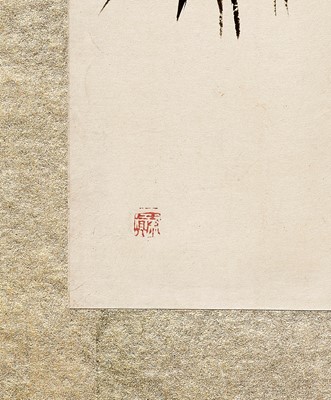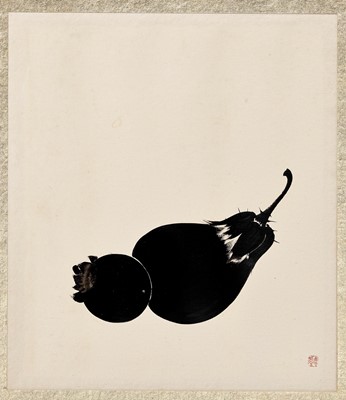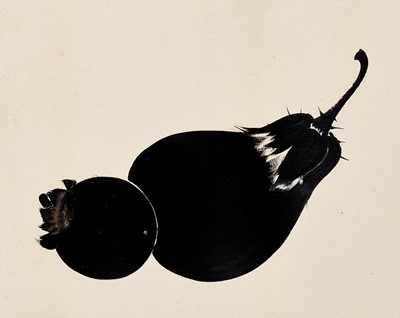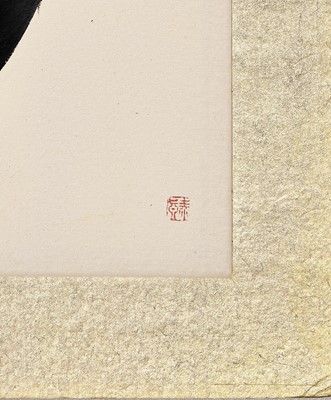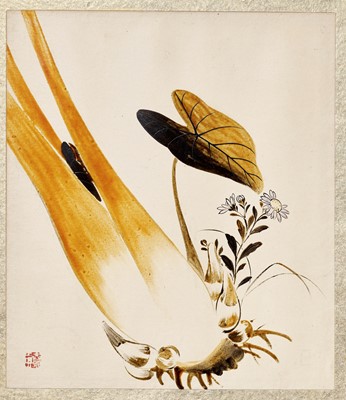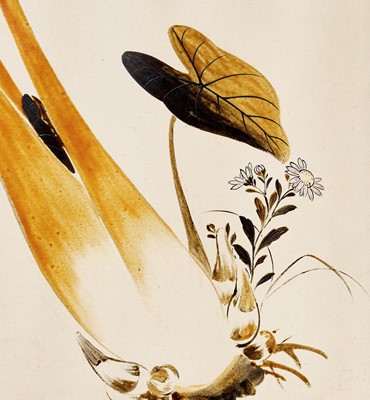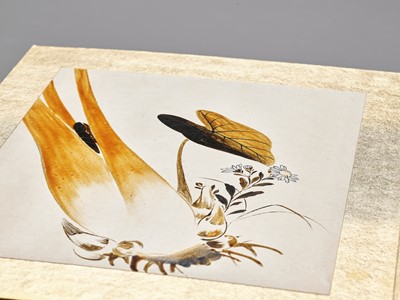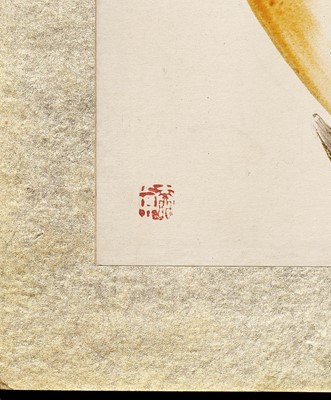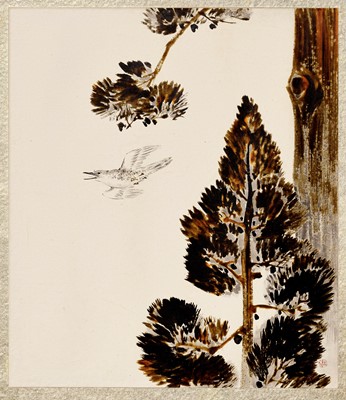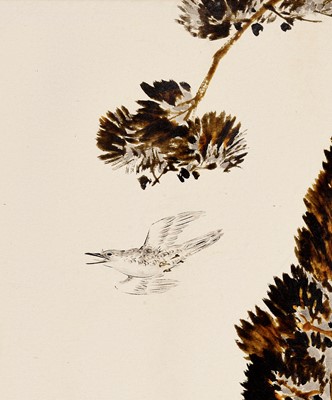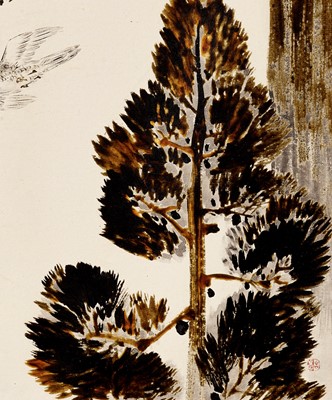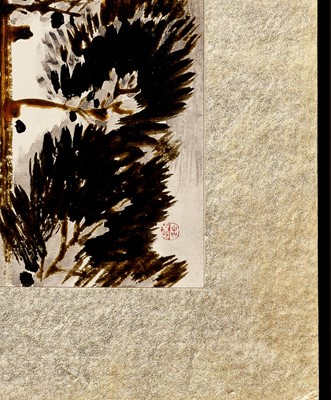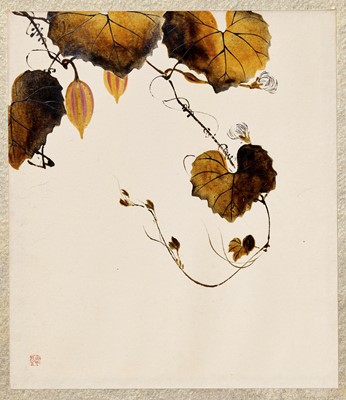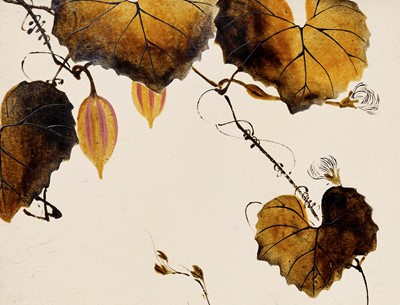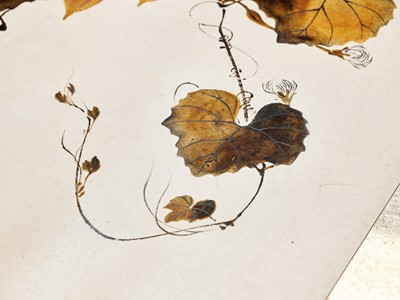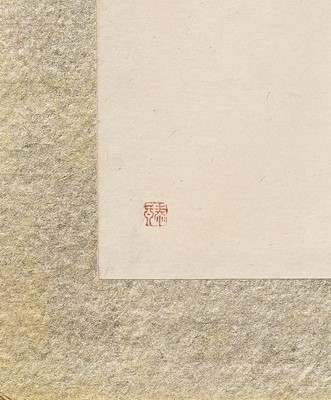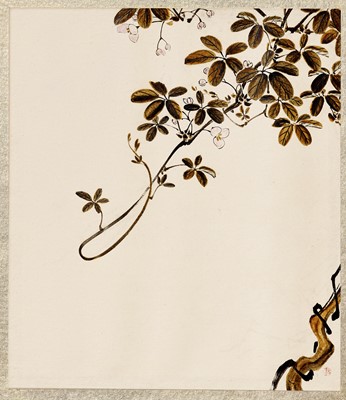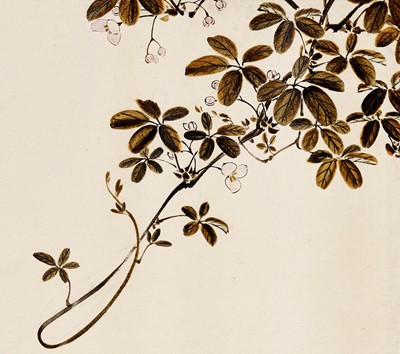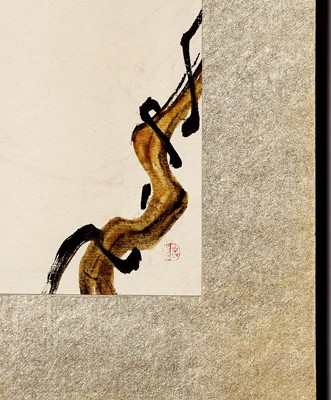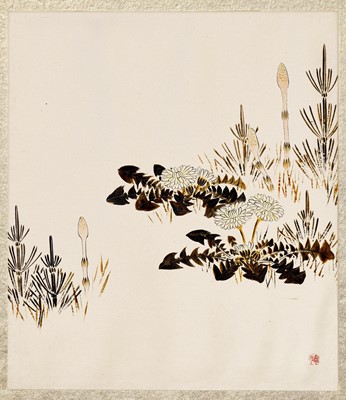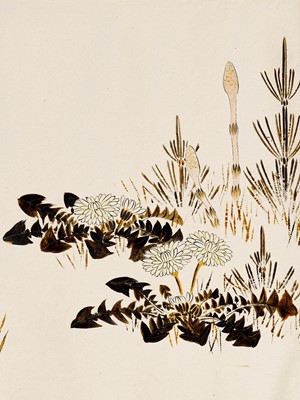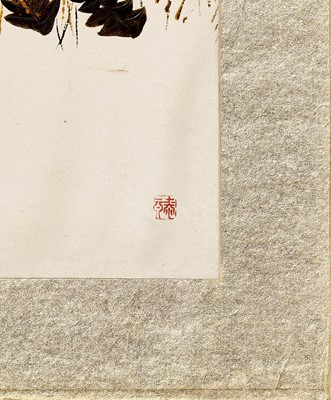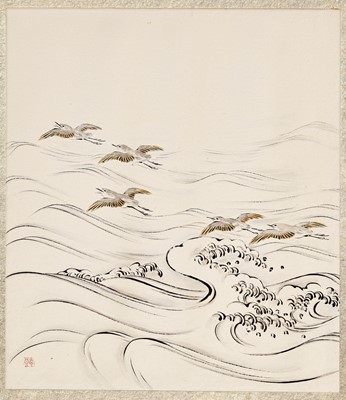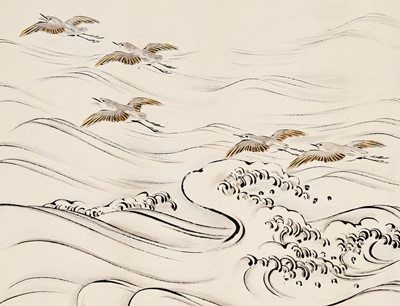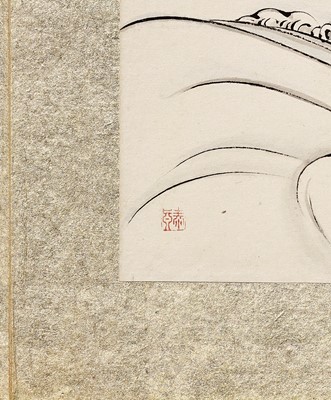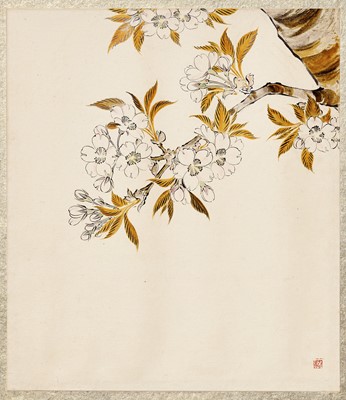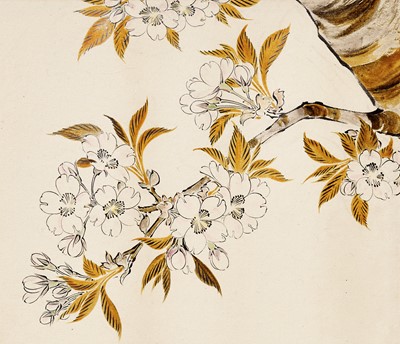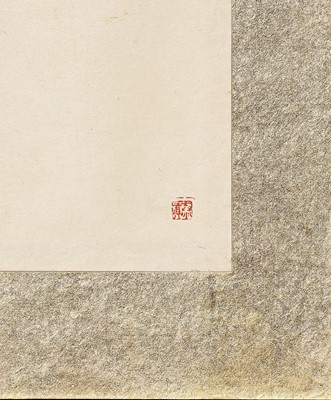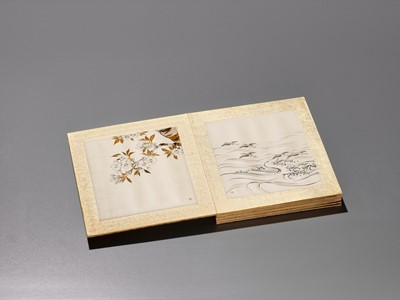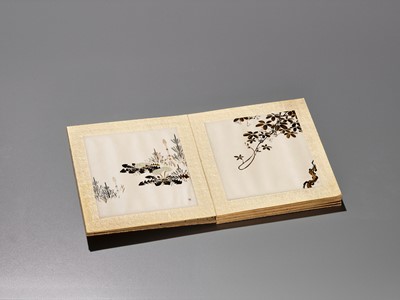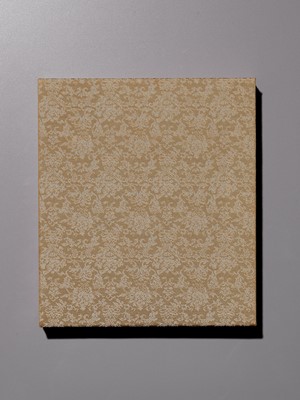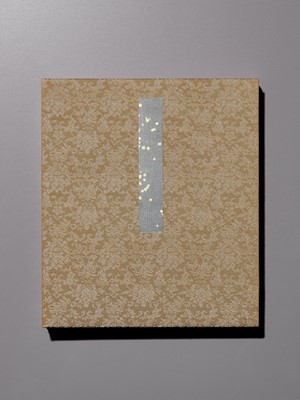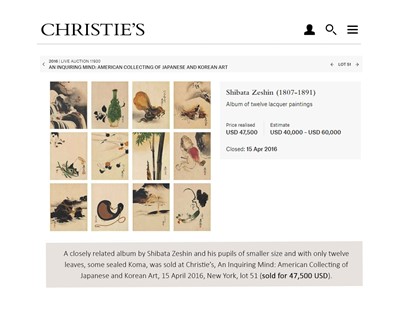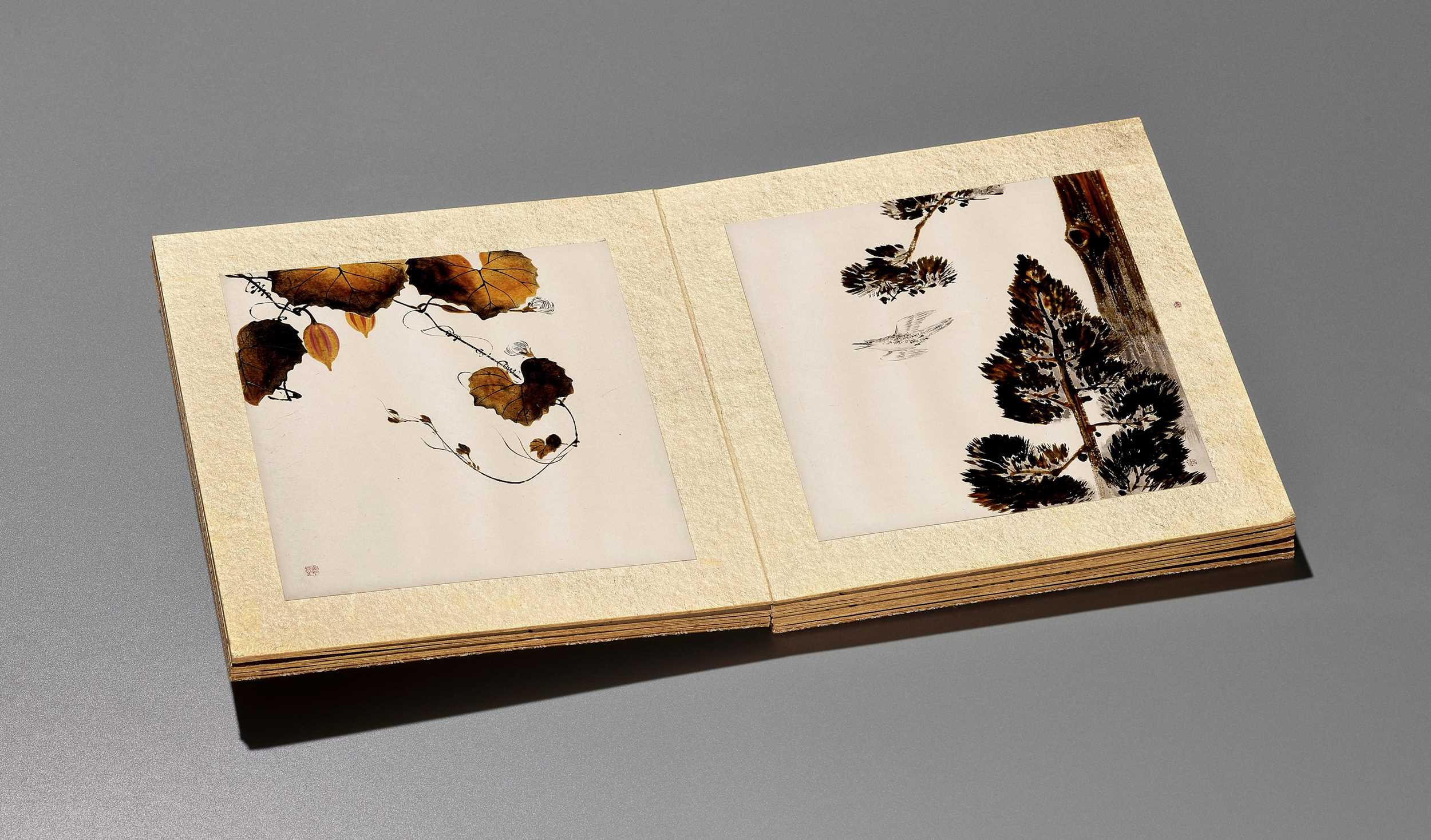1st Sep, 2022 13:00
Asian Art Discoveries - Japanese Art
281
IKEDA TAISHIN: A SUPERB ALBUM OF FOURTEEN URUSHI-E (LACQUER) PAINTINGS
Sold for €7,584
including Buyer's Premium
By Ikeda Taishin (1825-1923), each sealed Taishin or Koma
Japan, late 19th century, Meiji period (1868-1912)
The fourteen paintings mounted as an accordion album on gold paper with silk brocade cover and back, superbly painted with lacquer on paper, with subtle use of ink and watercolors, to depict various subjects: a gushing waterfall, cleverly indicated with subtle linework and negative space, the craggy rockwork finely painted with hues ranging from ochre-brown to gray-black; two reishi mushrooms growing from craggy and grassy rockwork, the fungi appealingly variegating in color from a deep dark-brown to a pale gray; a blossoming prunus tree, with only a part of the trunk and few branches and blossoms visible; a shoreside mountain landscape lined with trees above a path with three figures walking along it; two pine saplings with brown-lacquered trunks and dark leaves; a spray of bamboo leaves as well as three bamboo stalks, which are mostly off-image and lacquered a lustrous brownish-black; a particularly lustrous black-lacquered nazume (eggplant) and kaki (persimmon); a cluster of lotus leaves, zuiki (leaf stalks of hasuimo or lotus yam) and chrysanthemum, clearly painted in the form of a stylized crab with prominent pincers; a magpie in flight amid thickly grown pines, with the use of silver and dark-brown lacquers creating a striking contrast; two small gourds borne on wispy vines with large leaves, the veins finely painted in black lacquer; another prunus tree with thin branches and vines bearing neatly veined leaves and lavender-pink blossoms and bud; a garden with yellow chrysanthemums, bamboo, and dark weeds; a flock of plovers flying low above crashing waves with boldly painted sea foam; and blossoming camellia with finely veined brown leaves borne on a young branch, the trunk mostly off-image.
Each leaf is signed KOMA or TAISHIN to the lower right corner.
Condition: Excellent condition with minor wear and minimal soiling.
Provenance: Ex-collection Donald Mendelsohn. Christie’s, 11 December 1985, New York, lot 33. Sotheby’s, Fine Chinese Ceramics & Works Of Art Including Chinese And Japanese Art From The Collection Of Frieda And Milton Rosenthal, 16 September 2008, New York, lot 298. A private collector in New York, USA, acquired from the above.
SIZE 19.1 x 16.8 cm (each leaf) and 25.2 x 22 cm (the album)
Ikeda Taishin (1825-1903) was the leading pupil of Shibata Zeshin who worked in the Meiji period. He was born in Edo and became Zeshin’s first lacquer apprentice in 1835 at the age of eleven. He became an independent artist around 1870, approximately 35 years later. Together with Kawanobe Itcho (Genjiro; 1830-1910), Taishin was appointed an Artist to the Imperial Household (Teishitsu gigeiin) in 1896. His pupils included Umezawa Ryushin, a member of the Art committee of the Imperial Fine Arts Academy and the Imperial Household.
Auction comparison:
A closely related album by Shibata Zeshin and his pupils of smaller size and with only twelve leaves, some sealed Koma, was sold at Christie’s, An Inquiring Mind: American Collecting of Japanese and Korean Art, 15 April 2016, New York, lot 51 (sold for 47,500 USD).
By Ikeda Taishin (1825-1923), each sealed Taishin or Koma
Japan, late 19th century, Meiji period (1868-1912)
The fourteen paintings mounted as an accordion album on gold paper with silk brocade cover and back, superbly painted with lacquer on paper, with subtle use of ink and watercolors, to depict various subjects: a gushing waterfall, cleverly indicated with subtle linework and negative space, the craggy rockwork finely painted with hues ranging from ochre-brown to gray-black; two reishi mushrooms growing from craggy and grassy rockwork, the fungi appealingly variegating in color from a deep dark-brown to a pale gray; a blossoming prunus tree, with only a part of the trunk and few branches and blossoms visible; a shoreside mountain landscape lined with trees above a path with three figures walking along it; two pine saplings with brown-lacquered trunks and dark leaves; a spray of bamboo leaves as well as three bamboo stalks, which are mostly off-image and lacquered a lustrous brownish-black; a particularly lustrous black-lacquered nazume (eggplant) and kaki (persimmon); a cluster of lotus leaves, zuiki (leaf stalks of hasuimo or lotus yam) and chrysanthemum, clearly painted in the form of a stylized crab with prominent pincers; a magpie in flight amid thickly grown pines, with the use of silver and dark-brown lacquers creating a striking contrast; two small gourds borne on wispy vines with large leaves, the veins finely painted in black lacquer; another prunus tree with thin branches and vines bearing neatly veined leaves and lavender-pink blossoms and bud; a garden with yellow chrysanthemums, bamboo, and dark weeds; a flock of plovers flying low above crashing waves with boldly painted sea foam; and blossoming camellia with finely veined brown leaves borne on a young branch, the trunk mostly off-image.
Each leaf is signed KOMA or TAISHIN to the lower right corner.
Condition: Excellent condition with minor wear and minimal soiling.
Provenance: Ex-collection Donald Mendelsohn. Christie’s, 11 December 1985, New York, lot 33. Sotheby’s, Fine Chinese Ceramics & Works Of Art Including Chinese And Japanese Art From The Collection Of Frieda And Milton Rosenthal, 16 September 2008, New York, lot 298. A private collector in New York, USA, acquired from the above.
SIZE 19.1 x 16.8 cm (each leaf) and 25.2 x 22 cm (the album)
Ikeda Taishin (1825-1903) was the leading pupil of Shibata Zeshin who worked in the Meiji period. He was born in Edo and became Zeshin’s first lacquer apprentice in 1835 at the age of eleven. He became an independent artist around 1870, approximately 35 years later. Together with Kawanobe Itcho (Genjiro; 1830-1910), Taishin was appointed an Artist to the Imperial Household (Teishitsu gigeiin) in 1896. His pupils included Umezawa Ryushin, a member of the Art committee of the Imperial Fine Arts Academy and the Imperial Household.
Auction comparison:
A closely related album by Shibata Zeshin and his pupils of smaller size and with only twelve leaves, some sealed Koma, was sold at Christie’s, An Inquiring Mind: American Collecting of Japanese and Korean Art, 15 April 2016, New York, lot 51 (sold for 47,500 USD).
Zacke Live Online Bidding
Our online bidding platform makes it easier than ever to bid in our auctions! When you bid through our website, you can take advantage of our premium buyer's terms without incurring any additional online bidding surcharges.
To bid live online, you'll need to create an online account. Once your account is created and your identity is verified, you can register to bid in an auction up to 12 hours before the auction begins.
Intended Spend and Bid Limits
When you register to bid in an online auction, you will need to share your intended maximum spending budget for the auction. We will then review your intended spend and set a bid limit for you. Once you have pre-registered for a live online auction, you can see your intended spend and bid limit by going to 'Account Settings' and clicking on 'Live Bidding Registrations'.
Your bid limit will be the maximum amount you can bid during the auction. Your bid limit is for the hammer price and is not affected by the buyer’s premium and VAT. For example, if you have a bid limit of €1,000 and place two winning bids for €300 and €200, then you will only be able to bid €500 for the rest of the auction. If you try to place a bid that is higher than €500, you will not be able to do so.
Online Absentee and Telephone Bids
You can now leave absentee and telephone bids on our website!
Absentee Bidding
Once you've created an account and your identity is verified, you can leave your absentee bid directly on the lot page. We will contact you when your bids have been confirmed.
Telephone Bidding
Once you've created an account and your identity is verified, you can leave telephone bids online. We will contact you when your bids have been confirmed.
Classic Absentee and Telephone Bidding Form
You can still submit absentee and telephone bids by email or fax if you prefer. Simply fill out the Absentee Bidding/Telephone bidding form and return it to us by email at office@zacke.at or by fax at +43 (1) 532 04 52 20. You can download the PDF from our Upcoming Auctions page.
How-To Guides
How to Create Your Personal Zacke Account
How to Register to Bid on Zacke Live
How to Leave Absentee Bids Online
How to Leave Telephone Bids Online
中文版本的操作指南
创建新账号
注册Zacke Live在线直播竞拍(免平台费)
缺席投标和电话投标
Third-Party Bidding
We partner with best-in-class third-party partners to make it easy for you to bid online in the channel of your choice. Please note that if you bid with one of our third-party online partners, then there will be a live bidding surcharge on top of your final purchase price. You can find all of our fees here. Here's a full list of our third-party partners:
- 51 Bid Live
- EpaiLive
- ArtFoxLive
- Invaluable
- LiveAuctioneers
- the-saleroom
- lot-tissimo
- Drouot
Please note that we place different auctions on different platforms. For example, in general, we only place Chinese art auctions on 51 Bid Live.
Bidding in Person
You must register to bid in person and will be assigned a paddle at the auction. Please contact us at office@zacke.at or +43 (1) 532 04 52 for the latest local health and safety guidelines.
